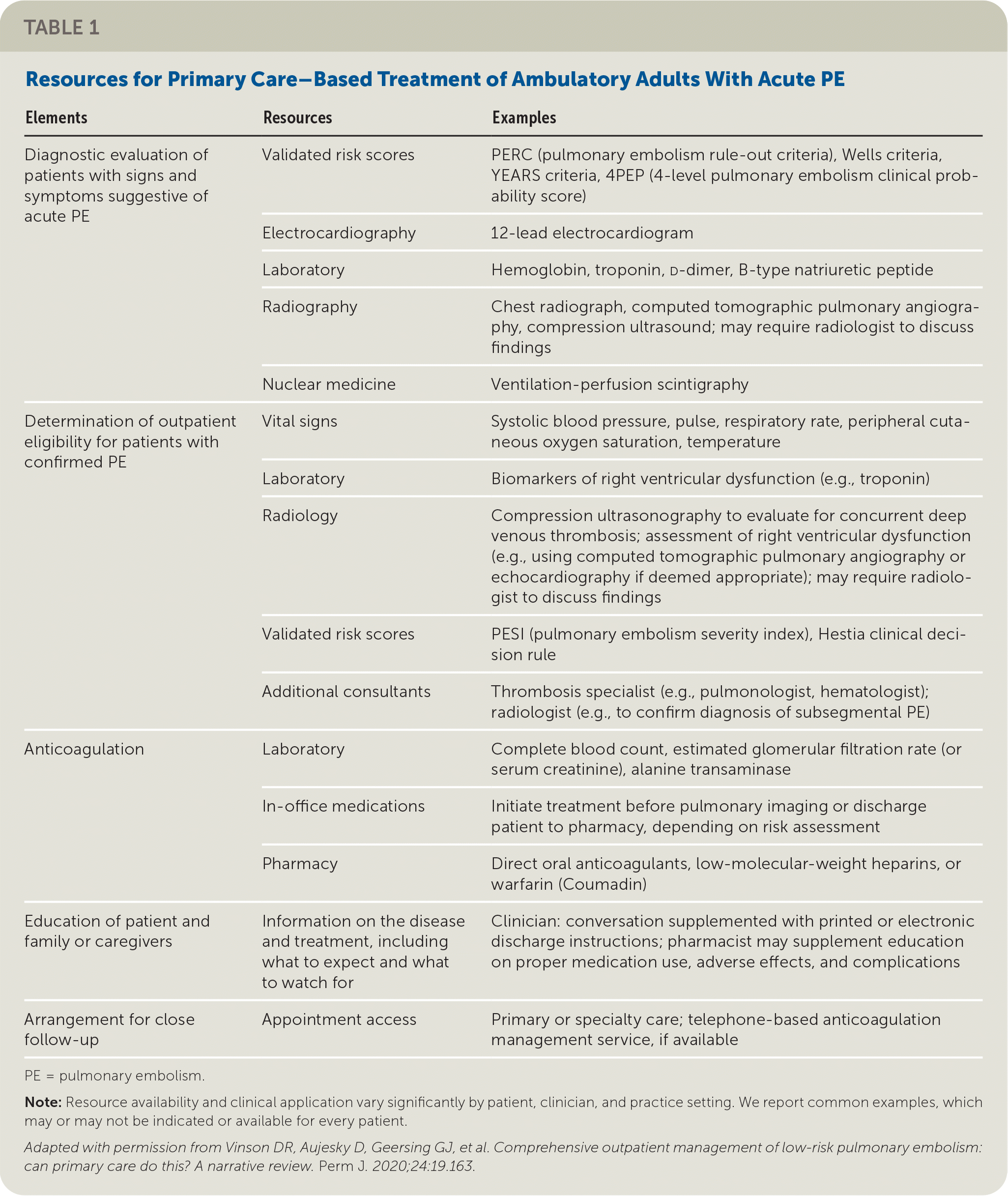
Am Fam Physician. 2022;106(5):online
Author disclosure: No relevant financial relationships.
To the Editor: Evidence shows that patients with acute pulmonary embolism (PE) can be treated as outpatients effectively and safely.1 Guidelines recommend outpatient treatment for patients who meet low-risk criteria; however, eligibility criteria vary.2,3 The American College of Chest Physicians recommends outpatient care for adults who meet the following criteria: “(1) clinically stable with good cardiopulmonary reserve; (2) no contraindications such as recent bleeding, severe renal or liver disease, or severe thrombocytopenia (i.e., < 50,000 per mm3); (3) expected to be compliant with treatment; and (4) the patient feels well enough to be treated at home.”2 The patient must also have access to treatment and follow-up care.
The definition of outpatient care varies in the literature.4 PE is most commonly diagnosed in the emergency department, but some studies include patients diagnosed in outpatient clinics.1 Another point of variation besides diagnostic location is the location and duration of medical observation between diagnosis and discharge. Most studies include an observation period involving prolonged emergency department monitoring and at least one night in an observation unit or inpatient ward.4 Until recently, only case reports described patients treated in the primary care setting without referral to a more specialized level of care.1,5
We recently published a retrospective multicenter cohort study describing the characteristics, treatment, and outcomes of adult patients diagnosed with acute PE in the primary care setting.6 From 2013 to 2019, investigators identified 652 patients whose community-based primary care clinicians (98% family medicine or internal medicine physicians) secured a diagnosis using computed tomographic pulmonary angiography or ventilation-perfusion scintigraphy. Outcomes of patients treated without hospitalization included seven-day hospitalization with symptoms related to PE and 30-day serious outcomes (i.e., major bleeding, recurrent venous thromboembolism, or all-cause mortality).
One-third of these patients were treated with a direct oral anticoagulant, and 20.5% (n = 134) went home from the clinic. Of the 79.5% (n = 518) who were referred to the emergency department, 196 (30% of the entire cohort) were discharged home after a brief evaluation (median = 3 hours). Of the 50.5% (n = 330) of total patients treated without hospitalization, 1.8% (n = 6) required hospitalization within seven days for symptoms related to PE, and 0.3% (n = 1) experienced a 30-day outcome (nonfatal worsening PE). This study is the first to demonstrate that outpatient treatment of patients in the primary care setting with acute PE can be feasible and safe (Table 11).6

| Elements | Resources | Examples |
|---|---|---|
| Diagnostic evaluation of patients with signs and symptoms suggestive of acute PE | Validated risk scores | PERC (pulmonary embolism rule-out criteria), Wells criteria, YEARS criteria, 4PEP (4-level pulmonary embolism clinical probability score) |
| Electrocardiography | 12-lead electrocardiogram | |
| Laboratory | Hemoglobin, troponin, d-dimer, B-type natriuretic peptide | |
| Radiography | Chest radiograph, computed tomographic pulmonary angiography, compression ultrasound; may require radiologist to discuss findings | |
| Nuclear medicine | Ventilation-perfusion scintigraphy | |
| Determination of outpatient eligibility for patients with confirmed PE | Vital signs | Systolic blood pressure, pulse, respiratory rate, peripheral cutaneous oxygen saturation, temperature |
| Laboratory | Biomarkers of right ventricular dysfunction (e.g., troponin) | |
| Radiology | Compression ultrasonography to evaluate for concurrent deep venous thrombosis; assessment of right ventricular dysfunction (e.g., using computed tomographic pulmonary angiography or echocardiography if deemed appropriate); may require radiologist to discuss findings | |
| Validated risk scores | PESI (pulmonary embolism severity index), Hestia clinical decision rule | |
| Additional consultants | Thrombosis specialist (e.g., pulmonologist, hematologist); radiologist (e.g., to confirm diagnosis of subsegmental PE) | |
| Anticoagulation | Laboratory | Complete blood count, estimated glomerular filtration rate (or serum creatinine), alanine transaminase |
| In-office medications | Initiate treatment before pulmonary imaging or discharge patient to pharmacy, depending on risk assessment | |
| Pharmacy | Direct oral anticoagulants, low-molecular-weight heparins, or warfarin (Coumadin) | |
| Education of patient and family or caregivers | Information on the disease and treatment, including what to expect and what to watch for | Clinician: conversation supplemented with printed or electronic discharge instructions; pharmacist may supplement education on proper medication use, adverse effects, and complications |
| Arrangement for close follow-up | Appointment access | Primary or specialty care; telephone-based anticoagulation management service, if available |
